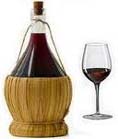Plates - 6
from Italian Traditional Food
Meissen plates
Check out these great Italian ideas at Amazon for Italian food and kitchen ideas.
<< Previous Page 6 Next
>>
Continuing the potted history of plates
....
Meissen porcelain
It is not seriously suggested that
you start collecting early Meissen porcelain unless you have unlimited funds and patience, the factory's early
development is interesting. It was the first place in western Europe to discover the Chinese formula for making
hard-paste porcelain, and the style and decoration of its wares had a profound and extensive influence on 18th
century china. Not until the outbreak of the Seven Years War in 1756 did it lose its European lead, which passed to
Sevres for the next twenty years.
Augustus the Strong, Elector of
Saxony, had a passion for collecting Chinese porcelain and as his collection increased, his state coffers emptied.
He heard of the researches of a promising young alchemist named Bottger, who was engaged in finding a way of
turning base metal into gold. Thinking that he might be a useful person to "protect", Augustus had him brought to
Dresden in 1701 and a year later a factory to house his experiments was built at Meissen, 12 miles from the royal
court.
Bottger didn't succeed in turning
dross into gold, but he did the next best thing. In 1707 he successfully imitated Chinese red stoneware, and by
1730 the factory was producing cut and polished articles of a higher quality than the original Chinese. Many pots
for infusing tea were made in the shape of the old Yi-Hsing wine jars, and this shape, in fact, has stayed with us
to this day.,
Manufacture of European
porcelain
Then, in 1709, Bottger rediscovered
hard-paste porcelain and a delighted Augustus ordered his court goldsmith to take a hand in the designing. The
manufacture of European porcelain had begun, and competitors soon appeared.
Meanwhile, at Meissen, money was
being spent in perfecting brilliant background colours, and the clear yellow, green, maroon and lilac formed the
inspiration for so much of the decoration on English porcelain. But despite a handsome reward offered by the
Elector, a satisfactory blue - like that of Sevres - was never found.
Delicate sprays of flowers and
lifelike birds were painted in "reserved" (plain) panels and later, Watteausque pastoral scenes were depicted on
plates. These heavily decorated pieces, too elaborate for today's taste, were copied all
over Europe.
Page 7 of this Italian Traditional Food article on plates can be found on the next
page.
<<
Previous Page 6 Next >>

Copyright © 2009 -
. All Rights Reserved Worldwide. Italian Traditional Food
You may not reprint articles from this website
without the written permission of the site owner.
Disclaimer: Articles on this
Website are provided for information purposes only. Italiantraditionalfood.com does not accept any responsibility
or liability for the use or misuse of the article content on this site or reliance by any person on the site's
contents.
| 


 Digg
Digg Stumbleupon
Stumbleupon Google Bookmarks
Google Bookmarks Delicious
Delicious Twitter
Twitter Facebook
Facebook Yahoo My Web
Yahoo My Web Reddit
Reddit